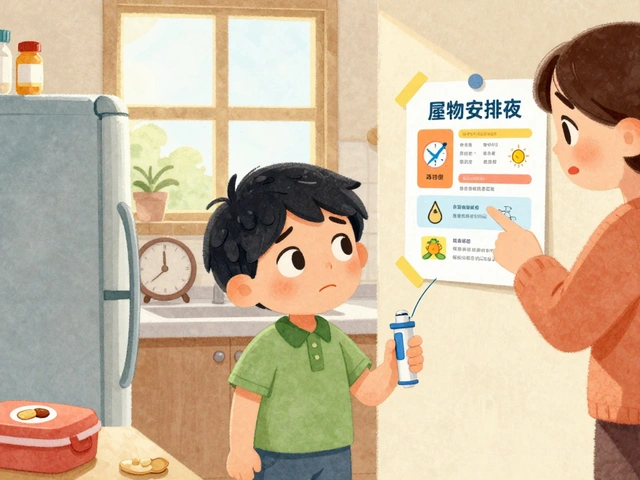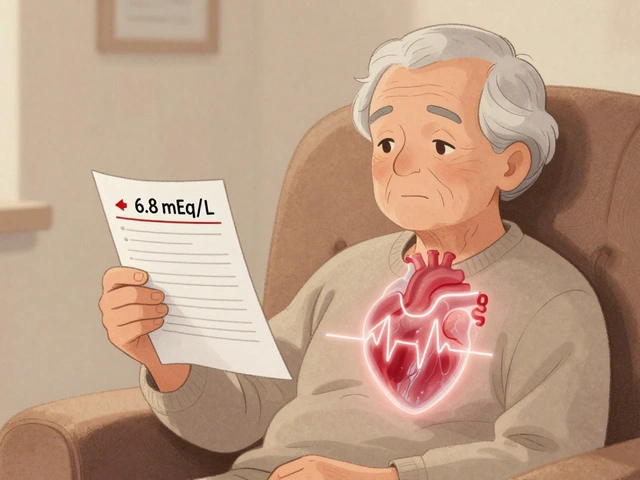27
Immunotherapy's Impact on Carcinoma Treatment: Current Strategies and Future Directions

Immunotherapy is a treatment that harnesses the patient’s own immune system to recognize and destroy cancer cells, characterized by approaches such as checkpoint inhibition, CAR‑T cell therapy, and therapeutic cancer vaccines. While conventional chemotherapy attacks rapidly dividing cells indiscriminately, immunotherapy aims for precision, often delivering durable responses even in advanced disease.
Understanding Immunotherapy in Carcinoma
Carcinomas-cancers arising from epithelial tissue-represent the majority of solid tumours, including lung, breast, colorectal, and prostate cancers. The immune system naturally surveys for abnormal cells, but tumours develop sophisticated ways to hide or suppress this surveillance. Immunotherapy intervenes by either releasing the brakes on immune cells or by engineering immune cells to better target the tumour.
Key Modalities Shaping Modern Carcinoma Care
Three pillars dominate the current landscape:
- Checkpoint inhibitors are drugs that block proteins such as PD‑1, PD‑L1, and CTLA‑4, allowing T‑cells to stay active against tumour cells.
- CAR‑T cell therapy involves extracting a patient’s T‑cells, genetically modifying them to express a chimeric antigen receptor (CAR) that recognises a tumour‑specific antigen, and reinfusing them.
- Cancer vaccines aim to educate the immune system about tumour‑associated neoantigens, prompting a targeted attack.
How Checkpoint Inhibitors Work
Under normal conditions, T‑cells express PD‑1, a receptor that binds to PD‑L1 on healthy cells, signalling the T‑cell to pause. Tumours often over‑express PD‑L1, effectively turning off the immune response. By blocking this interaction, drugs such as pembrolizumab (PD‑1 inhibitor) or atezolizumab (PD‑L1 inhibitor) restore T‑cell activity.
Another target, CTLA‑4, competes with the co‑stimulatory molecule CD28 for binding to B7 on antigen‑presenting cells. Ipilimumab, a CTLA‑4 blocker, amplifies the initial activation of T‑cells, especially in melanoma but increasingly in lung and renal carcinomas.
Clinical data from 2023 shows that combining PD‑1 and CTLA‑4 blockade yields response rates of 55% in metastatic non‑small cell lung cancer, compared with 30% for PD‑1 monotherapy.
CAR‑T Cell Therapy: From Blood Cancers to Solid Tumours
CAR‑T has transformed the treatment of certain haematologic malignancies, and researchers are adapting the technology for solid carcinomas. The process begins with a leukapheresis to collect peripheral blood mononuclear cells, followed by viral transduction to embed a CAR construct that recognises a tumour antigen such as HER2. After expansion, the engineered cells are infused back into the patient.
Early‑phase trials in HER2‑positive gastric cancer reported a 40% objective response rate, with median progression‑free survival of 8 months. However, on‑target off‑tumour toxicity remains a hurdle, as HER2 is also expressed in low levels on cardiac tissue.
Biomarkers and Patient Selection
Not every patient benefits from immunotherapy. Predictive biomarkers help match the right therapy to the right tumour.
- PD‑L1 expression measured by immunohistochemistry guides eligibility for PD‑1/PD‑L1 inhibitors; a cutoff of ≥1% is common for pembrolizumab in lung cancer.
- Tumour mutational burden (TMB) quantifies the number of mutations per megabase; high TMB (≥10 mut/Mb) predicts better response to checkpoint blockade.
- Microsatellite instability (MSI‑H) indicates defective DNA mismatch repair, a hallmark for pembrolizumab approval across tumour types.
Emerging blood‑based biomarkers such as circulating tumour DNA (ctDNA) dynamics are being studied to monitor early response and guide treatment duration.

Combination Strategies: Boosting Efficacy
Monotherapy works well for some patients, but many tumours are resistant. Combining immunotherapy with other modalities is now standard practice.
- Immunotherapy+Chemotherapy: Chemotherapy can increase antigen release, priming the immune system. Trials like KEYNOTE‑189 showed that pembrolizumab plus pemetrexed‑carboplatin improved overall survival to 22months versus 10.7months with chemotherapy alone in NSCLC.
- Immunotherapy+Radiation: Radiation induces immunogenic cell death, enhancing checkpoint inhibitor activity. The PACIFIC trial demonstrated durvalumab after chemoradiation extended median survival in stage III lung cancer to 47.5months.
- Immunotherapy+Targeted Therapy: Agents like EGFR inhibitors can modulate the tumour microenvironment. Early data suggest that osimertinib combined with atezolizumab yields higher response rates in EGFR‑mutated NSCLC, though safety signals require careful monitoring.
Regulatory Landscape and Access
Regulators worldwide have embraced immunotherapy’s promise. In the United States, the FDA granted tumour‑agnostic approval to pembrolizumab for any solid tumour with MSI‑H or high TMB, a first‑of‑its‑kind decision in 2020. The European Medicines Agency (EMA) followed with similar indications in 2022.
In the UK, NICE recommendations now list several checkpoint inhibitors as cost‑effective for metastatic melanoma, NSCLC, and urothelial carcinoma, provided patients meet biomarker criteria. However, reimbursement for CAR‑T in solid tumours remains limited, pending longer‑term efficacy data.
Practical Considerations for Clinicians
Delivering immunotherapy safely requires attention to unique adverse events, known as immune‑related adverse events (irAEs). Common irAEs include colitis, hepatitis, endocrinopathies, and pneumonitis. Early recognition-often within weeks of the first dose-allows prompt corticosteroid therapy, which mitigates severity without compromising anti‑tumour effect.
Key steps for a smooth rollout:
- Confirm biomarker status (PD‑L1, MSI‑H, TMB) using validated assays.
- Educate patients about potential irAEs and the importance of reporting new symptoms.
- Establish a multidisciplinary irAE management team (oncology, gastroenterology, endocrinology, pulmonology).
- Document treatment response using RECIST 1.1 for solid tumours and immune‑related response criteria (iRECIST) for immunotherapy.
- Consider de‑escalation or treatment holiday after sustained complete response, guided by ctDNA clearance.
Ultimately, integrating immunotherapy into carcinoma treatment hinges on personalised assessment-balancing tumour biology, patient comorbidities, and health‑system resources.
| Modality | Mechanism | Approved Indications (2024) | Typical IrAEs |
|---|---|---|---|
| Checkpoint Inhibitors | Blocks inhibitory receptors (PD‑1, PD‑L1, CTLA‑4) on T‑cells | NSCLC, melanoma, urothelial, HNSCC, gastric | Colitis, dermatitis, pneumonitis, endocrinopathies |
| CAR‑T Cell Therapy | Engineered T‑cells express antigen‑specific CAR | Approved for B‑cell leukemias; trials in HER2+, EGFR+ solid tumours | CRS, neurotoxicity, on‑target off‑tumour effects |
| Cancer Vaccines | Delivers tumour neoantigens to prime adaptive immunity | Proven for HPV‑related cervical cancer; experimental in melanoma | Injection site reactions, mild flu‑like symptoms |
Looking Ahead: The Next Wave of Immunotherapy
Future advances focus on three fronts:
- Bispecific antibodies that simultaneously engage T‑cells (via CD3) and tumour antigens, acting as off‑the‑shelf alternatives to CAR‑T.
- Neoantigen‑personalised vaccines created from next‑generation sequencing of each patient’s tumour, already showing 30% response in early trials.
- Microbiome modulation-dietary and probiotic interventions that may enhance checkpoint inhibitor efficacy, as demonstrated in a 2022 Dutch cohort.
As data accumulate, clinicians will have a richer toolbox to tailor immunotherapy, turning many carcinomas from fatal diseases into manageable chronic conditions.
Frequently Asked Questions
What is the main difference between checkpoint inhibitors and CAR‑T therapy?
Checkpoint inhibitors are drugs that release the brakes on existing T‑cells, letting the body’s natural immune response fight the tumour. CAR‑T therapy, on the other hand, creates a new army of engineered T‑cells that are programmed to recognise a specific tumour antigen before they are infused back into the patient.
Which biomarkers are most reliable for selecting patients for immunotherapy?
The strongest predictors are PD‑L1 expression (≥1% for many lung cancer protocols), high tumour mutational burden (≥10 mutations per megabase), and microsatellite instability‑high status. Emerging tests like circulating tumour DNA are promising but not yet standard.
Can immunotherapy be combined with chemotherapy safely?
Yes. Numerous phase III trials have shown that adding a checkpoint inhibitor to standard chemotherapy improves overall survival without dramatically increasing severe adverse events. Careful patient monitoring remains essential, especially for overlapping toxicities like neutropenia.
What are the most common immune‑related adverse events?
The most frequent irAEs affect the skin (rash, pruritus), gastrointestinal tract (colitis), liver (hepatitis), endocrine glands (thyroiditis, adrenal insufficiency), and lungs (pneumonitis). Early detection and corticosteroid treatment usually resolve symptoms while preserving anti‑tumour efficacy.
Is immunotherapy approved for all solid tumours?
Not yet. While checkpoint inhibitors have FDA and EMA approvals for several solid tumours-like NSCLC, melanoma, renal, and bladder cancers-others still rely on clinical trial evidence. Tumour‑agnostic approvals cover only MSI‑H or high TMB tumours, regardless of origin.
For anyone navigating carcinoma treatment, understanding immunotherapy-its mechanisms, biomarkers, combos, and real‑world challenges-helps turn uncertainty into a clear, actionable plan.









Alex Iosa
September 27, 2025 AT 20:58It is incumbent upon the medical establishment to disclose the hidden agendas influencing immunotherapy research, as the push for checkpoint inhibitors aligns conveniently with pharmaceutical profit motives. One must consider how regulatory bodies, often staffed by former industry executives, may prioritize market expansion over unbiased patient outcomes. Moreover, the acceleration of CAR‑T trials in solid tumours appears driven by shareholder expectations rather than solid scientific rationale. The ethical implications of such collusion demand vigilant scrutiny from the broader scientific community.
Mark Conner
October 16, 2025 AT 09:25Nothing beats good old American grit when we give our troops the right cancer weapons.
Abraham Gayah
November 3, 2025 AT 20:52Ah, the theater of modern oncology-so many lights, so little substance. One feels the weight of expectation as if the very air were seasoned with desperation. The grandiose promises of bispecific antibodies sound like a poet’s fever dream, yet the data are still shy of a standing ovation. Meanwhile, the patient stories drift past like background whispers, ignored by boardroom maestros. In the end, the drama is not on the lab bench but in the corridors where funding is allocated.
rajendra kanoujiya
November 22, 2025 AT 09:18Actually, the hype around combination therapy is overblown; the data are not as robust as advertised. While trials tout higher response rates, they often cherry‑pick patient subgroups with favorable biomarkers. The toxicity profile also climbs, making real‑world applicability questionable. It seems the community loves a good headline more than a nuanced risk‑benefit analysis.
Caley Ross
December 10, 2025 AT 21:45Just taking a step back to watch how these immunotherapy trends unfold. It’s clear there’s a lot of promise, but the reality on the bedside is a bit messier. We should keep an eye on irAE management protocols, as they’re the real gatekeepers of patient safety. At the same time, the field’s progress is undeniable, and that’s something worth noticing.